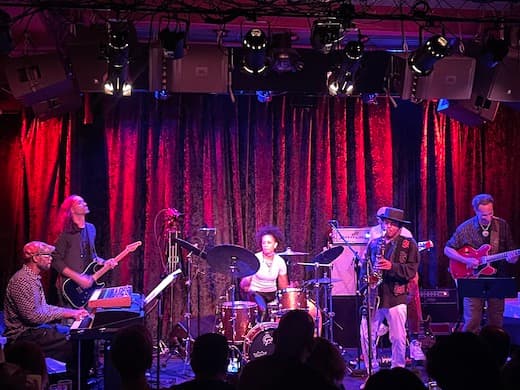Out of the Shadow of Lenny Kravitz, Cindy Blackman Santana Is a Natural Bandleader
It’s hard to imagine a situation where she is not in charge of everything. Like the great drummer-leaders of modern jazz, she determines more than the beat and the tempo.

Cindy Blackman Santana Band
Birdland
Through August 19
Upon hearing drummer Cindy Blackman Santana as a bandleader live at Birdland — where she is appearing through Saturday — two thoughts immediately sprang to mind. The first is that she is such a powerful and aggressive drummer that she simply has no choice but to be a bandleader.
Ms. Blackman-Santana first came to everyone’s attention through her 18-year tenure with Lenny Kravitz, but after hearing her with her sextet, it’s hard to imagine a situation where she is not in charge of everything. Like the great drummer-leaders of modern jazz — Max Roach, Art Blakey, and her own inspiration, as she has said, Tony Williams — she determines more than the beat and the tempo, setting the course for everything that happens on the bandstand.
The second thought is that Ms. Blackman Santana is one of the few major musicians out there who is equally versed in both jazz and rock. We could list plenty of players who concentrate on one but dabble in the other, but not so many who are at home in both worlds. She can play either straight ahead jazz (which seems to be the term we use for acoustic jazz that uses traditional harmonies) or out and out rock/pop (which is even harder to define). Yet because she’s comfortable with both idioms, what we call “fusion” — at least as it was defined 50 years ago — is a natural home for her.
Fusion is another one of those amorphous terms: Just as “big band” encompasses everything from Guy Lombardo to Count Basie, a fusion group could be anything from a rock band that incorporates elements of jazz improvisation to a jazz group that uses an electrified rhythm section. Ms. Blackman Santana’s music has deep roots in all of those 1970s groups that sprang forth from Miles Davis’s pioneering experiments at the end of the 1960s: Weather Report, Herbie Hancock’s Headhunters, Chick Corea’s various units, and Tony Williams’s own Lifetime band.
Ms. Blackman Santana’s group includes saxophonist Emilio Modeste, on the B flat double of soprano and tenor; Marc Cary on multiple electric keyboards; electric bassist Felix Pastorius (yes, the son of the legendary Jaco); and two guitarists. David Gilmore is listed on the Birdland calendar as “electric guitar” and Aurelien Budynek more simply as “guitar.”
Yet Mr. Gilmore honed closer to the definition of a jazz guitarist, phrasing more in single notes, a tradition that many trace back to Charlie Christian, while Mr. Budynek played in the colorful, fuzzy washes of sound that we associate with classic rock. They both have a very distinctive sound; there was no mistaking one for the other.
On the whole it was exciting — and loud — music. Sometimes it seems that electric bands invariably belong in a full-on concert setting; they can be rather intimidating in the relatively intimate space of a jazz club. Perhaps it was for that reason that Ms. Blackman Santana chose to begin with the remarkably and ironically subtle tune by Joe Zawinal that might be said to have launched the entire fusion movement, “In a Silent Way.”
This is such a subtle melody that I almost never recognize it, though I must have heard it a hundred times. The set included two other pieces from the transitional Davis-Williams period, “Frelon Bruin” and “Circle in the Round.” Many numbers seemed like riffs constructed around the leader’s drum patterns.
On the whole, the music embraced what always seemed to be the central contradiction in jazz-rock fusion: At the time it was new, many more conservative jazz fans — including my own much-younger self — viewed the entire movement as what Gary Giddins called a “sop to Mammon,” a music created to sell records rather than for any artistic purposes.
Time has shown that notion to be incorrect, especially since much of the music from the Miles axis is some of the most challenging in jazz: thick, thorny improvisations that reward close listening. At least one listener described “In a Silent Way” as “proto-ambient music,” but to me, it’s always been precisely the opposite: You have to pay twice as much attention to fully fathom what’s going on. In fact, the only element of the music that might be described as “commercial” is the electrification itself, and even that’s a stretch.
Throughout, Ms. Blackman Santana effectively demonstrated that this music isn’t all rocking-out-style aggression, that there is room for intimacy and introspection as well. The drummer-leader guided the music through at every step; at least a few pieces didn’t exactly E — in the tradition of later Miles Davis — but seamlessly transitioned into the next number; others came to a full stop.
As both player and bandleader, her drumming is forceful and flexible; she plays with power and energy, but is never rigid: Both the drums and the sextet as a whole seem open to all possibilities. Her music challenges the definition of what jazz is and isn’t, and that’s a good thing.

